Enhanced Catalytic Ozonation of Phenol Degradation by Mn-Loaded γ-Al2O3 Catalyst: A Facile Strategy for Treating Organic Wastewater
Abstract
:1. Introduction
2. Results
2.1. Morphology and Structure Characterization
2.2. Degradation of Phenol Wastewater by Mn/Al2O3 Catalyst
2.2.1. Absorption Effect of Mn/Al2O3 to Phenol
2.2.2. Effects of Catalyst Dosage on Catalytic Performance
2.2.3. Effects of pH on Catalytic Performance
2.2.4. Effects of Ozone Dosage on Catalytic Performance
2.2.5. Effects of Water Substrate on Catalytic Performance
2.3. Stability of Mn/Al2O3 Catalyst
3. Experimental Section
3.1. Experimental Materials
3.2. Preparation of the Catalysts
3.2.1. Activation Treatment of γ-Al2O3
3.2.2. Preparation of Mn Loaded γ-Al2O3 (Mn/Al2O3)
3.3. Characterization of the Catalyst
3.4. Ozone Catalytic Oxidation Experiment
4. Conclusions
Author Contributions
Funding
Data Availability Statement
Conflicts of Interest
References
- Kong, Z.; Li, L.; Xue, Y. Challenges and prospects for the anaerobic treatment of chemical industrial organic wastewater: A review. J. Clean. Prod. 2019, 231, 913–927. [Google Scholar] [CrossRef]
- Li, J.; Yuan, X.; Zhao, H.P. Highly efficient one-step advanced treatment of biologically pretreated coking wastewater by an integration of coagulation and adsorption process. Bioresour. Technol. 2018, 247, 1206–1209. [Google Scholar] [CrossRef] [PubMed]
- Zhu, H.; Ma, W.; Han, H.; Han, Y.; Ma, W. Catalytic ozonation of quinoline using nano-MgO: Efficacy, pathways, mechanisms and its application to real biologically pretreated coal gasification wastewater. Chem. Eng. J. 2017, 327, 91–99. [Google Scholar] [CrossRef]
- Huang, J.W.; Puyang, C.P.; Wang, Y.W.; Zhang, J.W.; Guo, H. Hydroxylamine activated by discharge plasma for synergetic degradation of tetracycline in water: Insight into performance and mechanism. Sep. Purif. Technol. 2022, 300, 121913. [Google Scholar] [CrossRef]
- Wu, H.Y.; Li, C.T.; Zhao, L.K. Removal of gaseous elemental mercury by cylindrical activated coke loaded with CoOx-CeO2 from simulated coal combustion flue gas. Energy Fuels 2015, 29, 6747–6757. [Google Scholar] [CrossRef]
- Deng, S.; Jothinathan, L.; Cai, Q.; Li, R.; Wu, M.; Ong, S.L.; Hu, J. FeOx@GAC catalyzed microbubble ozonation coupled with biological process for industrial phenolic wastewater treatment: Catalytic performance, biological process screening and microbial characteristics. Water Res. 2021, 190, 116687. [Google Scholar] [CrossRef]
- Tyagi, M.; Rana, A.; Kumari, S.; Jagadevan, S. Adsorptive removal of cyanide from coke oven wastewater onto zero-valent iron: Optimization through response surface methodology, isotherm and kinetic studies. J. Clean. Prod. 2018, 20, 398–407. [Google Scholar] [CrossRef]
- Zhang, S.Y.; Wu, C.Y.; Zhou, Y.X.; Wang, Y.N.; He, X.W. Effect of wastewater particles on catalytic ozonation in the advanced treatment of petrochemical secondary effluent. Chem. Eng. J. 2018, 345, 280–289. [Google Scholar] [CrossRef]
- Wu, M.; Kwok, Y.H.; Zhang, Y.; Szeto, W.; Huang, H.; Leung, D.Y.C. Synergetic effect of vacuum ultraviolet photolysis and ozone catalytic oxidation for toluene degradation over MnO2-rGO composite catalyst. Chem. Eng. Sci. 2021, 231, 116288. [Google Scholar] [CrossRef]
- Ghuge, S.P.; Saroha, A.K. Catalytic ozonation for the treatment of synthetic and industrial effluents-Application of mesoporous materials: A review. J. Environ. Manag. 2018, 211, 83–102. [Google Scholar] [CrossRef]
- Hassani, E.K.; Kalnina, D.; Turks, M.; Beakou, B.H.; Anouar, A. Enhanced degradation of an azo dye by catalytic ozonation over Ni-containing layered double hydroxide catalyst. Sep. Purif. Technol. 2019, 210, 764–774. [Google Scholar] [CrossRef]
- Jayanti, M.; Lodh, B.K.; Sharma, R.; Mahata, N.; Shah, M.P.; Mandal, S.; Ghanta, S.; Bhunia, B. Advanced oxidation process for the treatment of industrial wastewater: A review on strategies, mechanisms, bottlenecks and prospects. Chemosphere 2023, 345, 140473. [Google Scholar] [CrossRef]
- Tan, X.Q.; Wan, Y.F.; Huang, Y.J.; He, C.; Zhang, Z.L.; He, Z.Y.; Hu, L.L.; Zeng, J.W.; Shu, D. Three-dimensional MnO2 porous hollow microspheres for enhanced activity as ozonation catalysts in degradation of bisphenol A. J. Hazard. Mater. 2017, 321, 162–172. [Google Scholar] [CrossRef] [PubMed]
- Li, X.; Chen, W.; Ma, L.; Huang, Y.; Wang, H. Characteristics and mechanisms of catalytic ozonation with Fe-shaving-based catalyst in industrial wastewater advanced treatment. J. Clean. Prod. 2019, 222, 174–181. [Google Scholar] [CrossRef]
- Huang, X.; Cui, W.; Yu, J.; Lu, S.; Liao, X. Preparation of Mesoporous MnO2 Catalysts with Different Morphologies for Catalytic Ozonation of Organic Compounds. Catal. Lett. 2022, 152, 1441–1450. [Google Scholar] [CrossRef]
- Yeşil, R.; Çetinkaya, S. Mn3O4/p(DCPD)HIPE nanocomposites as an efficient catalyst for oxidative degradation of phenol. J. Nanoparticle Res. 2020, 22, 198. [Google Scholar] [CrossRef]
- Chaliha, S.; Bhattacharyya, K.G. Using Mn(II)−MCM41 as an Environment-Friendly Catalyst to Oxidize Phenol, 2-Chlorophenol, and 2-Nitrophenol in Aqueous Solution. Ind. Eng. Chem. Res. 2008, 47, 1370–1379. [Google Scholar] [CrossRef]
- Wang, X.P.; Yang, Z.H.; Jiang, Y.Q.; Zhao, P.Q.; Meng, X. Adsorption and catalytic degradation of phenol in water by a Mn, N co-doped biochar via a non-radical oxidation process. Sep. Purif. Technol. 2024, 330, 125267. [Google Scholar] [CrossRef]
- Xu, Y.; Lin, Z.; Zheng, Y.; Dacquin, J.; Royer, S.; Zhang, H. Mechanism and kinetics of catalytic ozonation for elimination of organic compounds with spinel-type CuAl2O4 and its precursor. Sci. Total Environ. 2019, 651, 2585–2596. [Google Scholar] [CrossRef]
- Bing, J.; Hu, C.; Zhang, L. Enhanced mineralization of pharmaceuticals by surface oxidation over mesoporous γ-Ti-Al2O3 suspension with ozone. Appl. Catal. B Environ. 2017, 202, 118–126. [Google Scholar] [CrossRef]
- Chen, W.; Li, X.; Pan, Z.; Ma, S.; Li, L. Synthesis of MnOx/SBA-15 for norfloxacin degradation by catalytic ozonation. Sep. Purif. Technol. 2017, 173, 99–104. [Google Scholar] [CrossRef]
- Xu, X.; Zhao, J.; Jiang, Y.; Tang, X.; Zhou, Z.; Zhu, Y. Promotion of catalytic ozonation of aniline with Mn-Ce-Ox/γ-Al2O3. Water Sci. Technol. 2018, 78, 339–346. [Google Scholar] [CrossRef] [PubMed]
- Li, X.; Chen, W.; Tang, Y.; Li, L. Relationship between the structure of Fe-MCM-48 and its activity in catalytic ozonation for diclofenac mineralization. Chemosphere 2018, 206, 615–621. [Google Scholar] [CrossRef] [PubMed]
- He, S.; Luan, P.; Mo, L.; Xu, J.; Li, J.; Zhu, L.; Zeng, J. Mineralization of recalcitrant organic pollutants in pulp and paper mill wastewaters through ozonation catalyzed by Cu-Ce supported on Al2O3. Bioresources 2018, 13, 3686–3703. [Google Scholar] [CrossRef]
- EzhilRaj, A.M.; Victora, S.G.; Jothy, V.B.; Ravidhas, C.; Wollschlager, J.; Suendorf, M.; Neumann, M.; Jayachandran, M.; Sanjeeviraja, C. XRD and XPS characterization of mixed valence Mn3O4 hausmannite thin films prepared by chemical spray pyrolysis technique. Appl. Surf. Sci. 2010, 256, 2920–2926. [Google Scholar] [CrossRef]
- Zhong, S.F.; Zhang, H.C. Mn(III)-ligand complexes as a catalyst in ligand-assisted oxidation of substituted phenols by permanganate in aqueous solution. J. Hazard. Mater. 2020, 384, 121404. [Google Scholar] [CrossRef] [PubMed]
- Xu, S.; Wen, L.; Yu, C.; Li, S.; Tang, J. Activation of peroxymonosulfate by MnFe2O4@BC composite for bisphenol A degradation: The coexisting of free-radical and non-radical pathways. Chem. Eng. J. 2022, 442, 136250. [Google Scholar] [CrossRef]
- Resende, K.; Braga, A.H.; Noronha, F.B.; Hori, C.E. Hydrodeoxygenation of phenol over Ni/Ce1−xNbxO2 catalysts. Appl. Catal. B Environ. 2019, 15, 100–113. [Google Scholar] [CrossRef]
- Uematsu, T.; Miyamoto, Y.M.; Ogasawara, Y.; Suzuki, K.; Yamaguchi, N. Mizuno Molybdenum-doped α-MnO2 as an efficient reusable heterogeneous catalyst for aerobic sulfide oxygenation. Catal. Sci. Technol. 2016, 6, 222–233. [Google Scholar] [CrossRef]
- Ma, G.; Tang, W.; Wang, A.; Zhang, L.; Guan, J.; Han, N.; Chen, Y. Heterogeneity CuO/Cu2O catalyst for highly efficient ozone removal. J. Environ. Sci. 2023, 125, 340–348. [Google Scholar] [CrossRef]
- Wang, W.L.; Hu, H.Y.; Liu, X.; Shi, H.X.; Zhou, T.H.; Wang, C.; Wu, Q.Y. Combination of catalytic ozonation by regenerated granular activated carbon (rGAC) and biological activated carbon in the advanced treatment of textile wastewater for reclamation. Chemosphere 2019, 231, 369–377. [Google Scholar] [CrossRef] [PubMed]
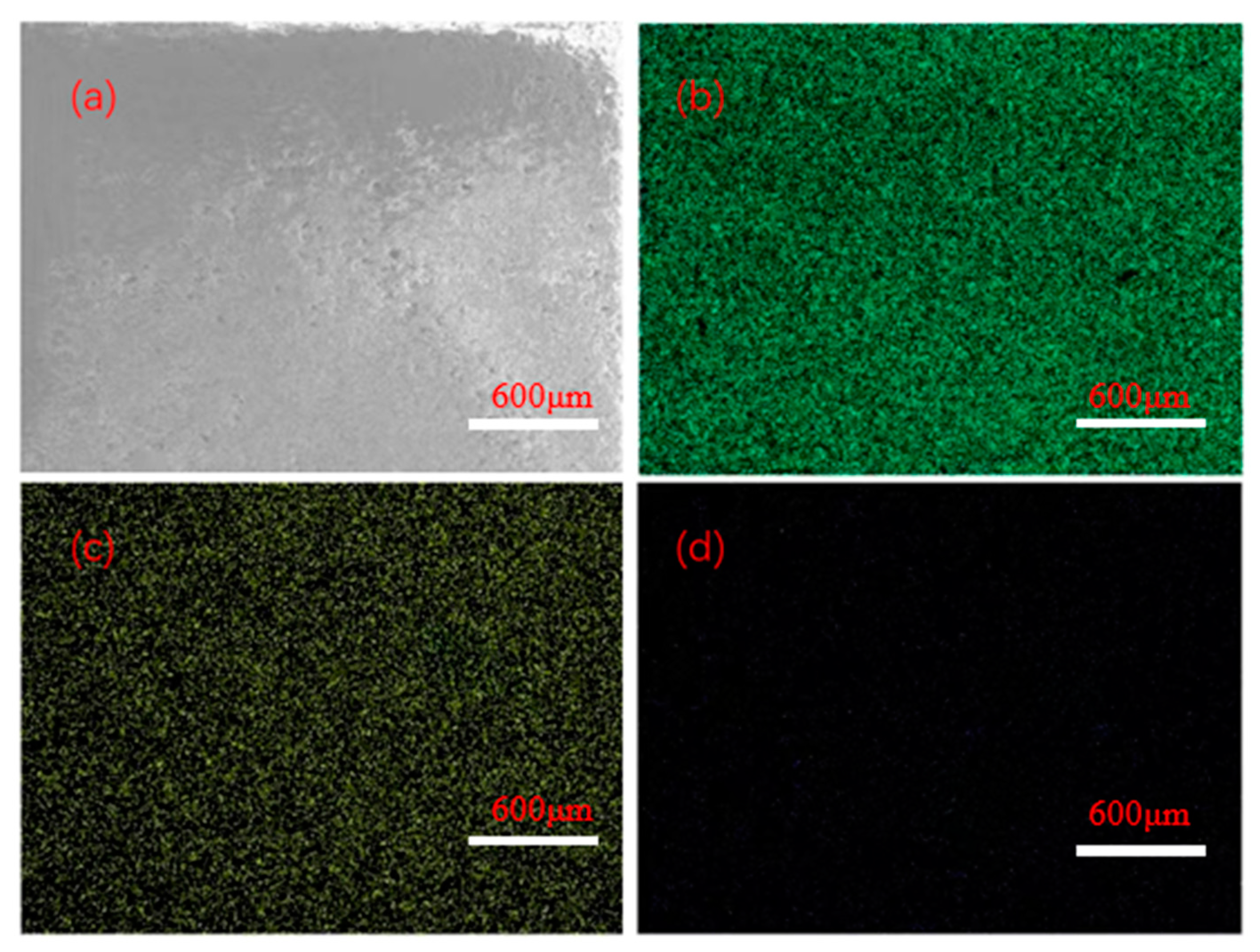
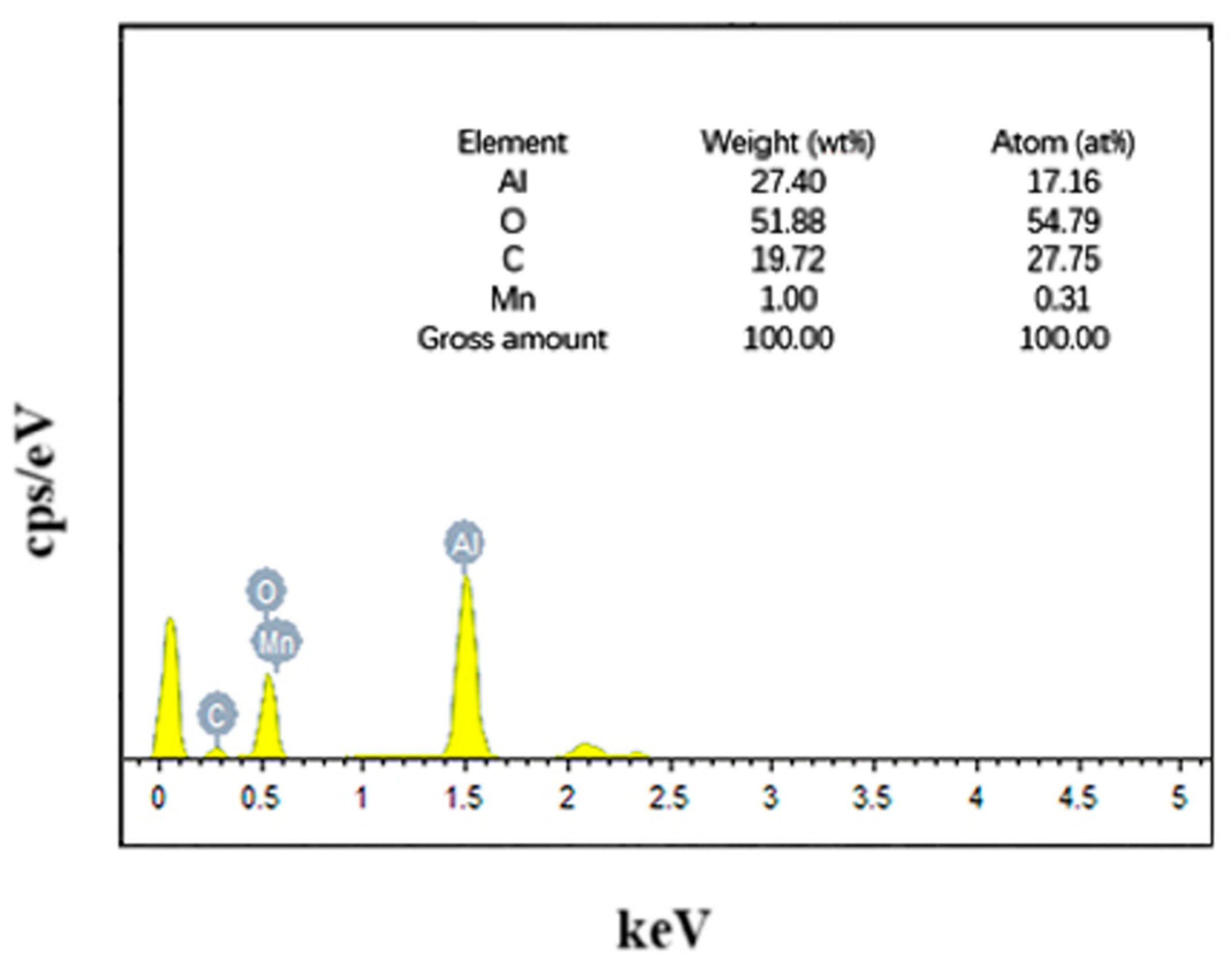

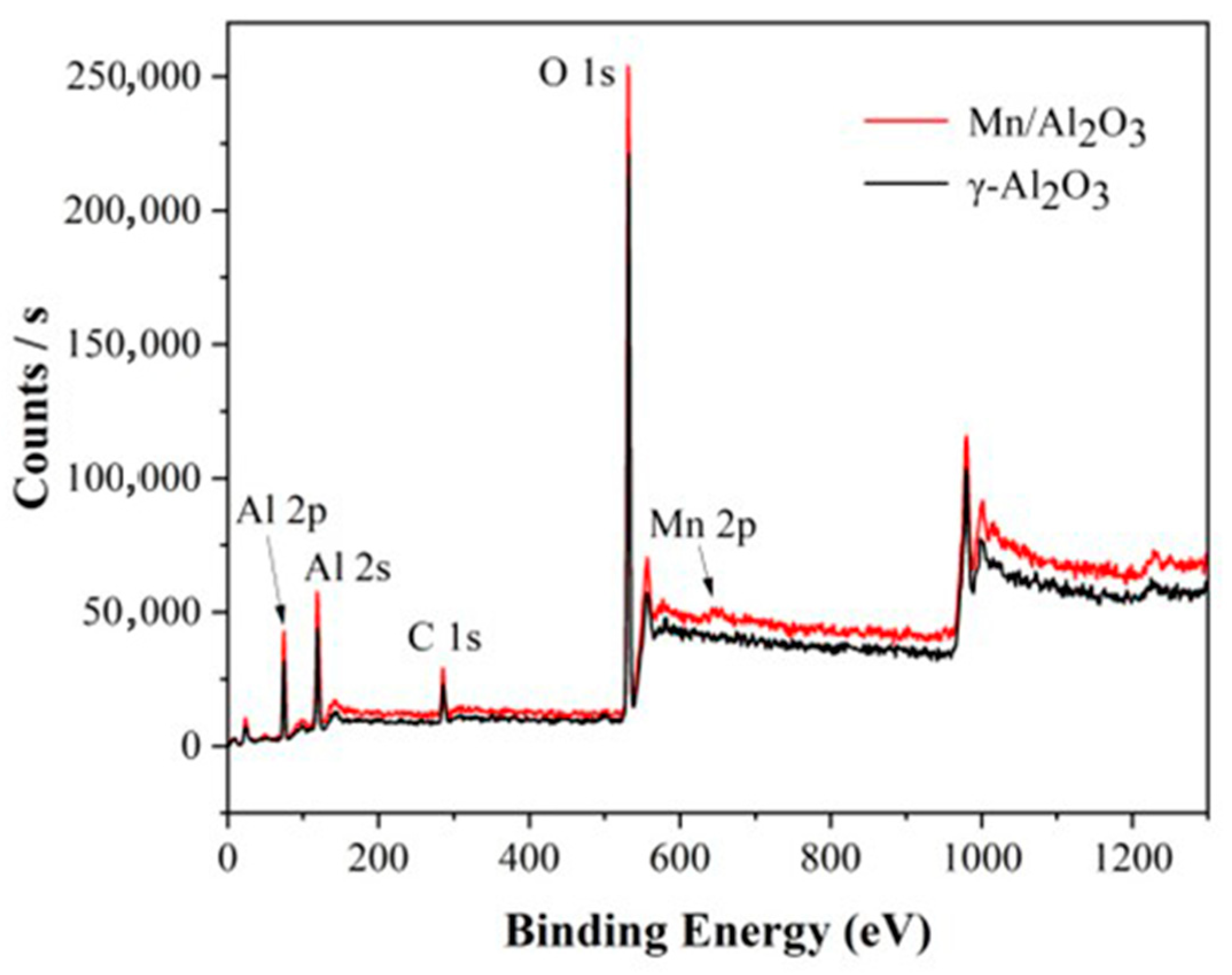
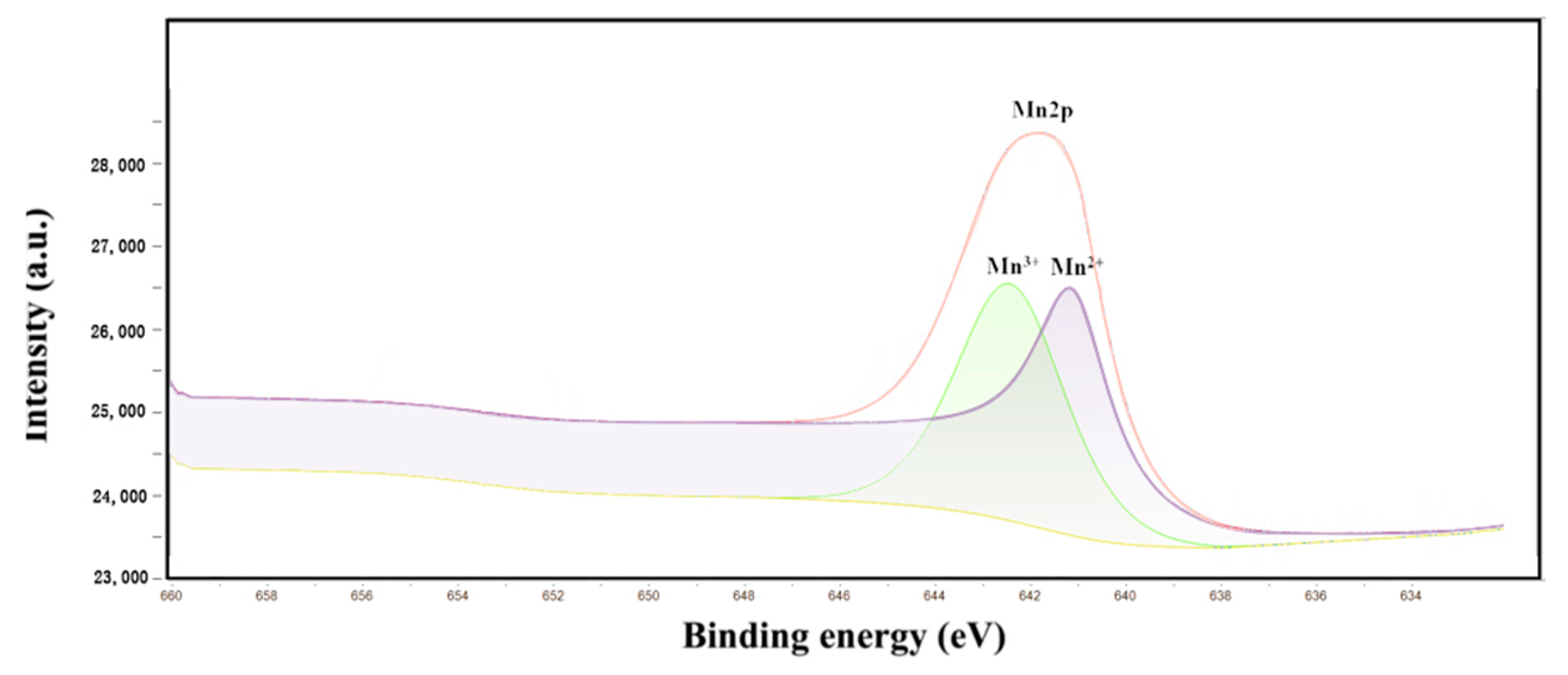
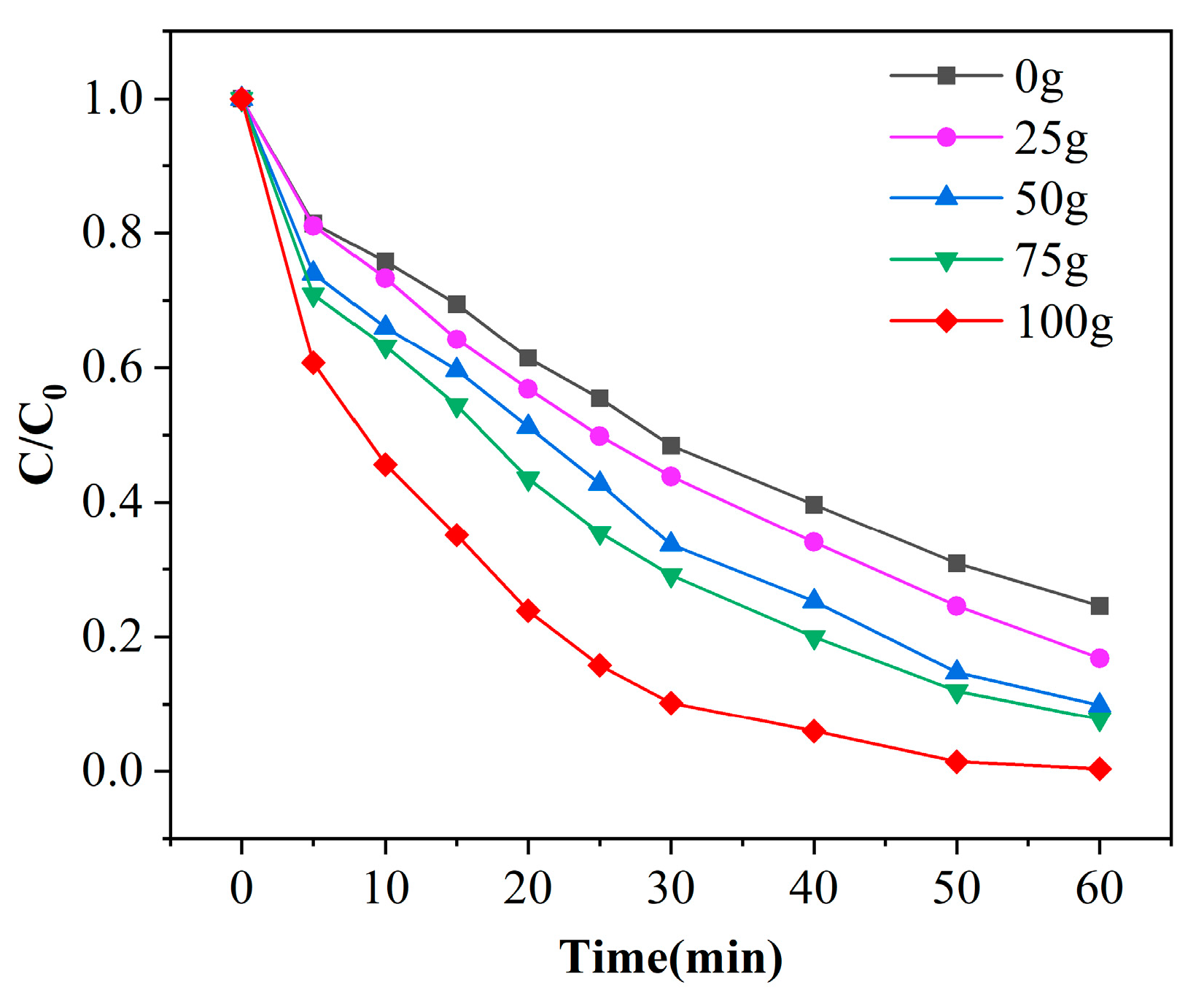

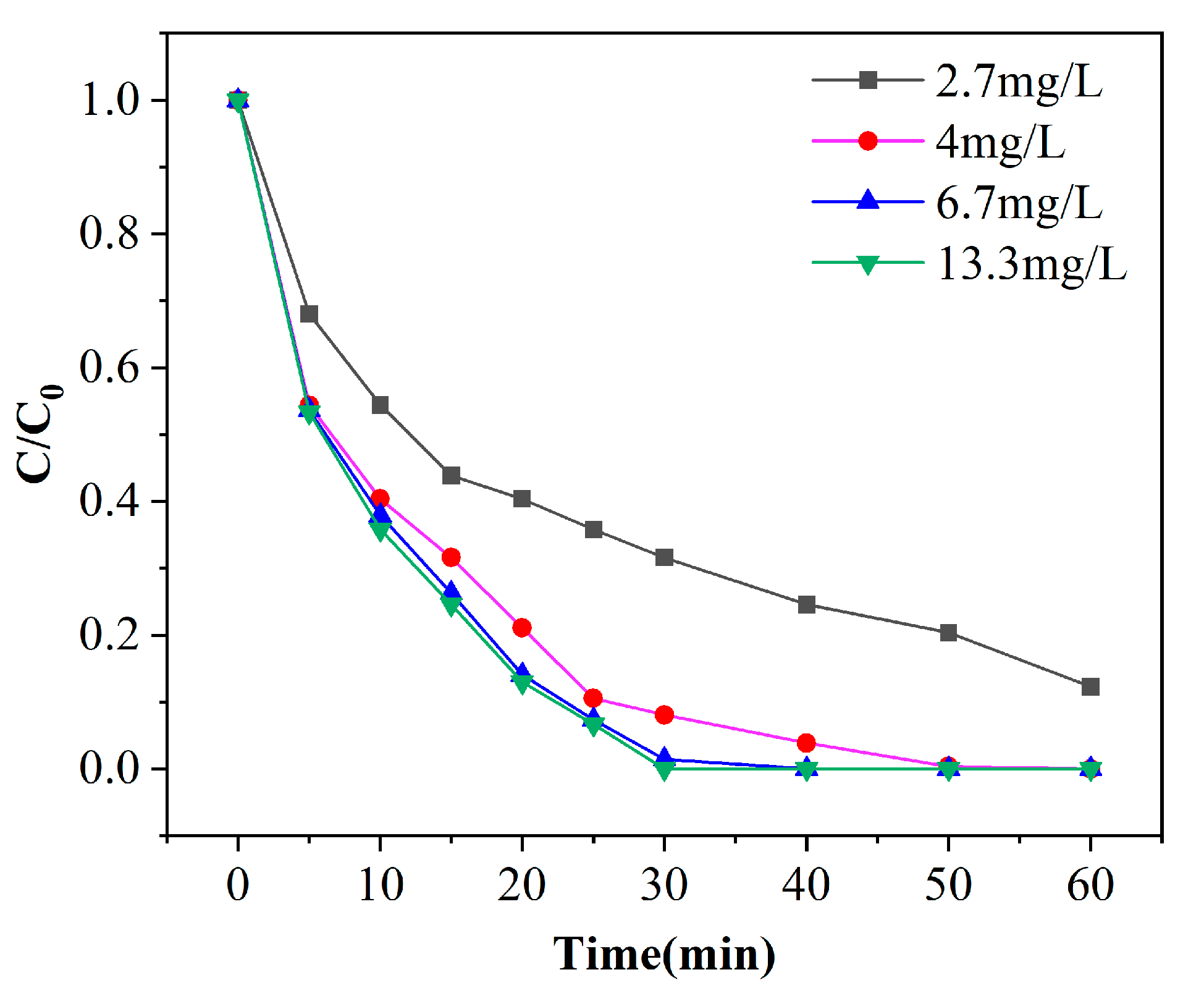

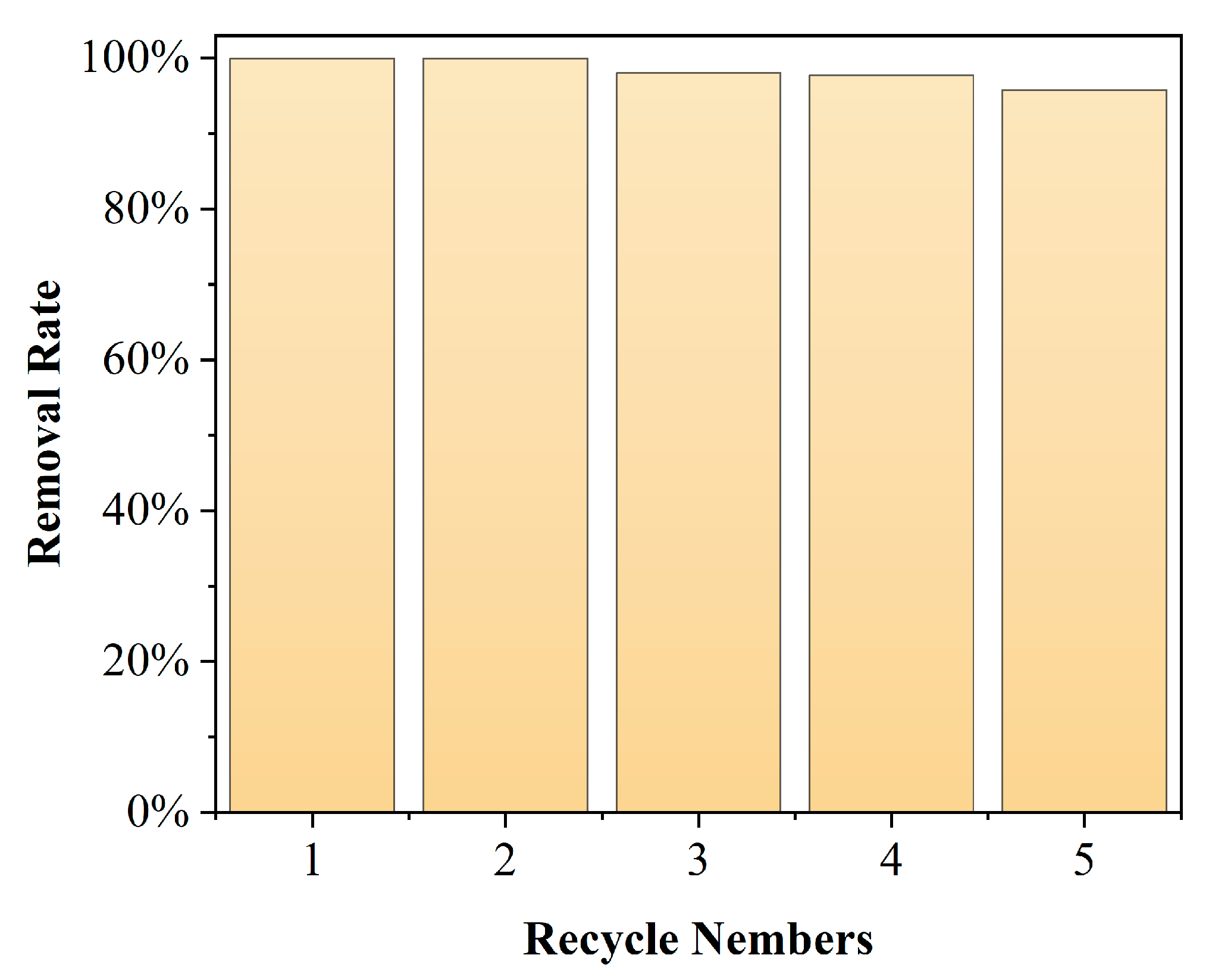
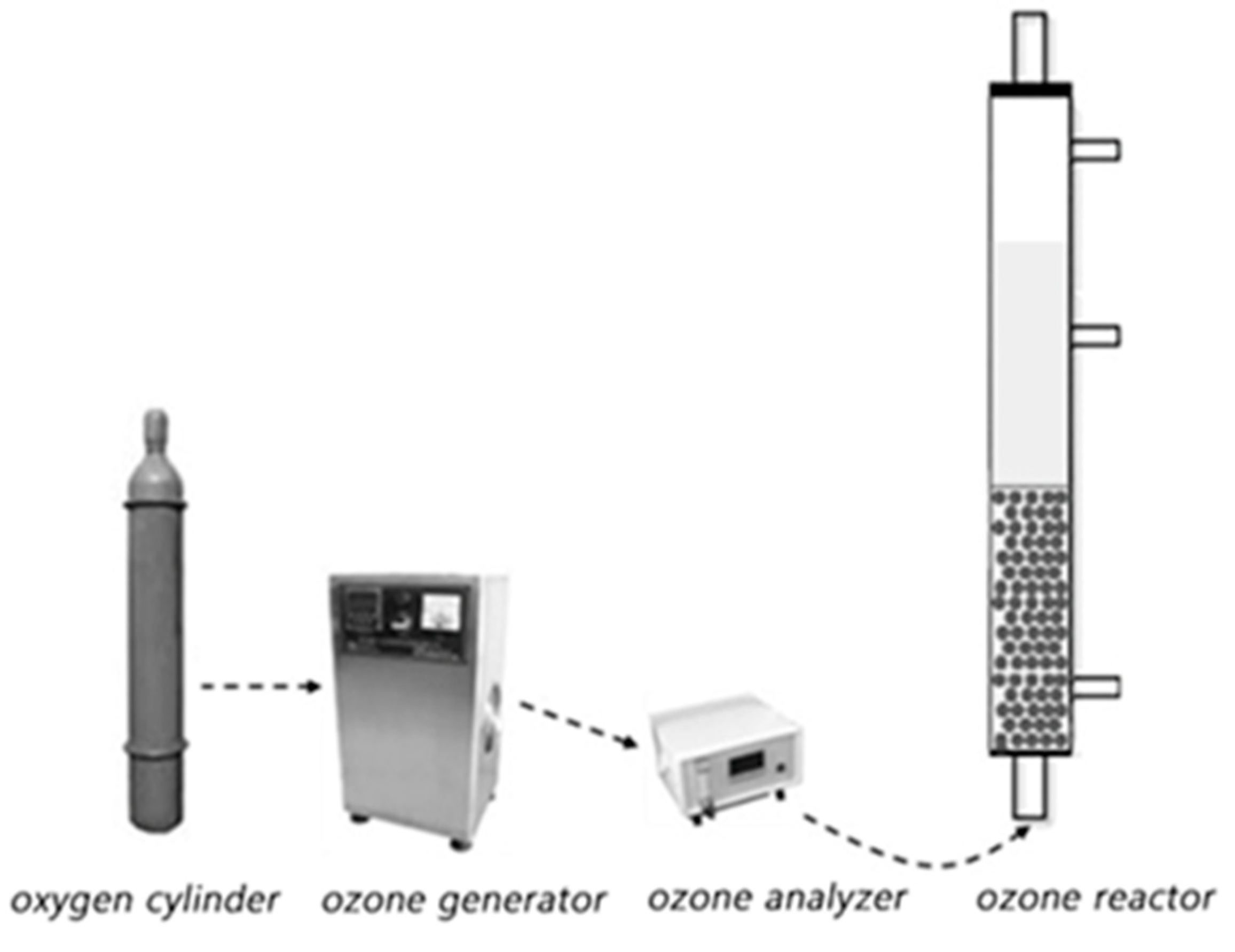
| Element | Weight (wt%) | Atom (at%) |
|---|---|---|
| Al | 34.39 | 22.45 |
| O | 51.10 | 56.27 |
| C | 14.51 | 21.28 |
| Gross amount | 100.00 | 100.00 |
Disclaimer/Publisher’s Note: The statements, opinions and data contained in all publications are solely those of the individual author(s) and contributor(s) and not of MDPI and/or the editor(s). MDPI and/or the editor(s) disclaim responsibility for any injury to people or property resulting from any ideas, methods, instructions or products referred to in the content. |
© 2023 by the authors. Licensee MDPI, Basel, Switzerland. This article is an open access article distributed under the terms and conditions of the Creative Commons Attribution (CC BY) license (https://creativecommons.org/licenses/by/4.0/).
Share and Cite
Yuan, S.; Zhu, X.; Zhu, M.; Zhou, H.; Pan, S. Enhanced Catalytic Ozonation of Phenol Degradation by Mn-Loaded γ-Al2O3 Catalyst: A Facile Strategy for Treating Organic Wastewater. Catalysts 2024, 14, 29. https://doi.org/10.3390/catal14010029
Yuan S, Zhu X, Zhu M, Zhou H, Pan S. Enhanced Catalytic Ozonation of Phenol Degradation by Mn-Loaded γ-Al2O3 Catalyst: A Facile Strategy for Treating Organic Wastewater. Catalysts. 2024; 14(1):29. https://doi.org/10.3390/catal14010029
Chicago/Turabian StyleYuan, Siwen, Xiao Zhu, Mingxin Zhu, Hua Zhou, and Shunlong Pan. 2024. "Enhanced Catalytic Ozonation of Phenol Degradation by Mn-Loaded γ-Al2O3 Catalyst: A Facile Strategy for Treating Organic Wastewater" Catalysts 14, no. 1: 29. https://doi.org/10.3390/catal14010029







